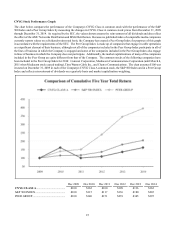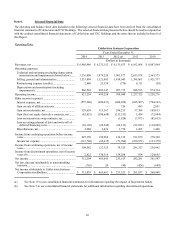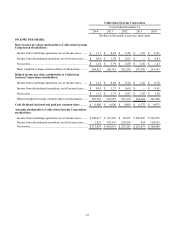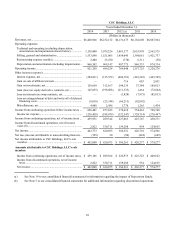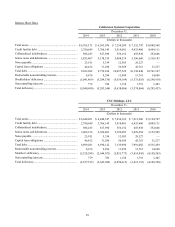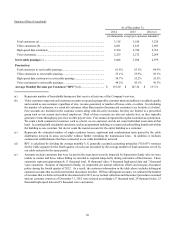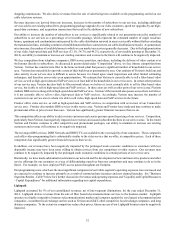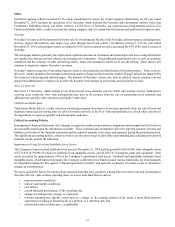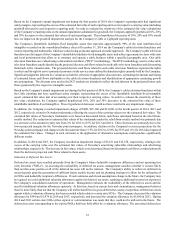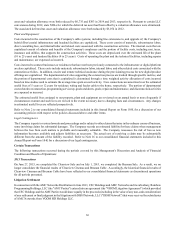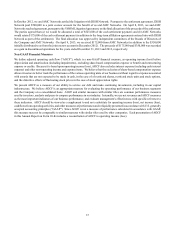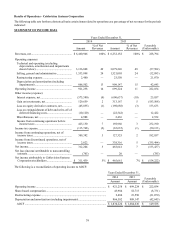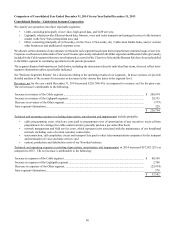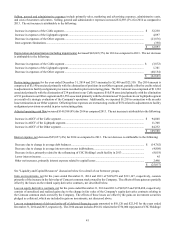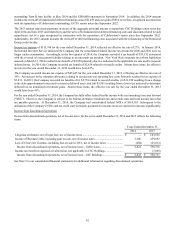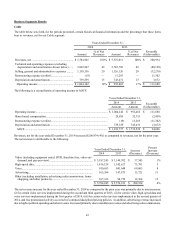Cablevision 2014 Annual Report Download - page 40
Download and view the complete annual report
Please find page 40 of the 2014 Cablevision annual report below. You can navigate through the pages in the report by either clicking on the pages listed below, or by using the keyword search tool below to find specific information within the annual report.
34
The Company assesses these qualitative factors to determine whether it is necessary to perform the two-step quantitative goodwill
impairment test. This quantitative test is required only if the Company concludes that it is more likely than not that a reporting
unit's fair value is less than its carrying amount.
When the qualitative assessment is not used, or if the qualitative assessment is not conclusive, the Company is required to determine
goodwill impairment using a two-step process. The first step of the goodwill impairment test is used to identify potential impairment
by comparing the fair value of a reporting unit with its carrying amount, including goodwill utilizing an enterprise-value based
premise approach. If the carrying amount of a reporting unit exceeds its fair value, the second step of the goodwill impairment
test is performed to measure the amount of impairment loss, if any. The second step of the goodwill impairment test compares
the implied fair value of the reporting unit's goodwill with the carrying amount of that goodwill. If the carrying amount of the
reporting unit's goodwill exceeds the implied fair value of that goodwill, an impairment loss is recognized in an amount equal to
that excess. The implied fair value of goodwill is determined in the same manner as the amount of goodwill that would be recognized
in a business combination. For the purpose of evaluating goodwill impairment at the annual impairment test date, the Company
had two reporting units containing approximately 97% of the Company's goodwill balance of $264,690. These reporting units are
Cable ($234,290) and Lightpath ($21,487).
The Company assesses the qualitative factors discussed above to determine whether it is necessary to perform the one-step
quantitative identifiable indefinite-lived intangible assets impairment test. This quantitative test is required only if the Company
concludes that it is more likely than not that a unit of accounting’s fair value is less than its carrying amount. When the qualitative
assessment is not used, or if the qualitative assessment is not conclusive, the impairment test for identifiable indefinite-lived
intangible assets requires a comparison of the estimated fair value of the intangible asset with its carrying value. If the carrying
value of the intangible asset exceeds its fair value, an impairment loss is recognized in an amount equal to that excess. The
following table sets forth the amount of identifiable indefinite-lived intangible assets reported in the Company's consolidated
balance sheet as of December 31, 2014:
Reportable Segment Unit of Accounting
Identifiable
Indefinite-
Lived Intangible
Assets Balance
Cable ................................................................... Cable Television Franchises................................... $ 731,848
Other.................................................................... Newsday Trademarks.............................................. 7,000
Cable ................................................................... Other indefinite-lived intangibles........................... 250
$ 739,098
For other long-lived assets, including intangible assets that are amortized, the Company evaluates assets for recoverability when
there is an indication of potential impairment. If the undiscounted cash flows from a group of assets being evaluated is less than
the carrying value of that group of assets, the fair value of the asset group is determined and the carrying value of the asset group
is written down to fair value.
In assessing the recoverability of the Company's goodwill and other long-lived assets, the Company must make assumptions
regarding estimated future cash flows and other factors to determine the fair value of the respective assets. These estimates and
assumptions could have a significant impact on whether an impairment charge is recognized and also the magnitude of any such
charge. Fair value estimates are made at a specific point in time, based on relevant information. These estimates are subjective
in nature and involve uncertainties and matters of significant judgments and therefore cannot be determined with precision. Changes
in assumptions could significantly affect the estimates. Estimates of fair value are primarily determined using discounted cash
flows and comparable market transactions. These valuations are based on estimates and assumptions including projected future
cash flows, discount rate, determination of appropriate market comparables and determination of whether a premium or discount
should be applied to comparables. For the Cable reportable segment, these valuations also include assumptions for average annual
revenue per customer, number of serviceable passings, operating margin and market penetration as a percentage of serviceable
passings, among other assumptions. Further, the projected cash flow assumptions consider contractual relationships, customer
attrition, eventual development of new technologies and market competition. For Newsday, these valuations also include
assumptions for advertising and circulation revenue trends, operating margin, market participant synergies, and market multiples
for comparable companies. If these estimates or material related assumptions change in the future, the Company may be required
to record impairment charges related to its long-lived assets.



